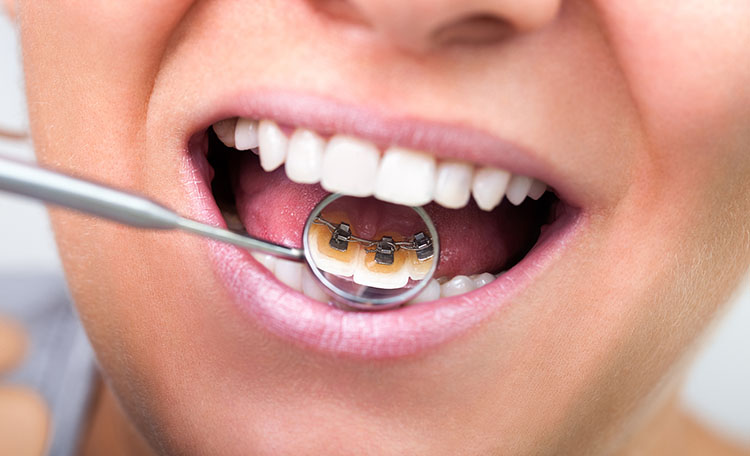
Lingual braces are a lesser known orthodontic option that has practical and cosmetic advantages when compared to alternative braces. They have some similarities to other braces, but because they are installed on the back of the teeth rather than the front where traditional braces are placed, they have some differences with respect to comfort, fit and ability to be discreet. We’ll explore these differences further and discuss what factors should be considered before getting lingual braces.
What Are Lingual Braces?
Lingual braces are similar to traditional braces in that brackets and wires are installed in the mouth and on the teeth to fix misalignments. However, lingual braces differ because they are almost entirely invisible. They are placed on the back of the teeth facing the tongue, rather than the front of the teeth. Because of this, lingual braces allow for a more discreet option for orthodontic patients not willing to wear traditional braces for a lengthy amount of time. They are gaining popularity for this reason, for both children and adults.
How Lingual Braces are Placed
The brackets used with lingual braces are customized to fit each patient’s mouth perfectly, using an impression of the teeth, and must be installed onto each individual tooth to properly correct misalignments. Likewise, the wires connecting each bracket require some customization to serve each patient best.
Having the perfect fit is essential when it comes to installing lingual braces because the brackets and wires are more challenging to place. The backs of the teeth are harder to reach, and there is much less room for the orthodontist to work. In order to properly position the lingual braces, all the brackets are cemented on the teeth at the same time using a customized tray to hold them in place. In contrast, traditional braces use standardized brackets that are placed individually, one tooth at a time.
Benefits of Lingual Braces
The most significant advantage many patients find with lingual braces is the ability to be more discreet when correcting their teeth. For adults, in particular, wearing bulky metal braces for years is not the ideal option in social or professional situations. Lingual braces are hidden behind the teeth, giving patients access to all the benefits of metal braces without being as obvious.
Besides being virtually invisible, lingual braces are just as efficient as other options when it comes to complex misalignments, including correcting rotations, closing gaps due to extractions or evening out the height of teeth. Also, any discoloration or white spots resulting from wearing braces will be on the inside of the teeth rather than the outside as with traditional metal or ceramic braces. Lingual braces are also custom fit for every patient, which can give a higher level of comfort.
Disadvantages to Lingual Braces
Lingual braces may create some issues for patients with an extreme or deep overbite. This is because the overbite may exert too much pressure on the brackets on the back of the teeth and cause them to detach too easily. Your orthodontist can tell you if this will be a problem in your case.
Lingual braces can also cause some difficulties with speech, especially while patients are still adjusting after the brackets are placed. Since the braces are on the backside of your teeth, it may feel a little unusual at first. You might have a lisp until you become accustomed to them because your tongue makes contact with the back of your teeth when you articulate. This effect will usually go away with time, though.
As with most braces, some discomfort or sores may develop. In the case of lingual braces, the soreness is mostly felt on the tongue, particularly while eating or speaking. However, the pain and irritation will decrease the longer you wear the braces.
Other Factors to Consider
As with any orthodontic option, patients need to consider their own personal preferences and what will work best for their lifestyle. As with metal braces, there are particular things that you should avoid eating with lingual braces, including foods that are hard, crunchy or very sticky. Food that gets stuck behind your teeth can take some extra effort to clean and rinse away. If this could be problematic for you, it may be best to consider another option, such as Invisalign.
Another factor to consider is the fact that lingual braces are usually more expensive than traditional braces. This is a reflection of the customization required with lingual braces and having to fit each bracket perfectly to each tooth. Other braces options are more standardized, making them more affordable in the long run.
The length of time that lingual braces need to be worn varies among patients. Most people will wear them between one and two years before they get the desired results. Extreme cases may take longer. During the time you wear them, regular visits will be necessary every few months for adjustments. The time that needed to wear lingual braces is generally right on par with traditional braces.
Growing Interest in Lingual Braces
With more patients asking about lingual braces, orthodontists and dental professionals are looking into this option as an effective alternative to traditional or ceramic braces. However, not every orthodontist has experience installing and treating misalignments with lingual braces. Be sure to ask your dentist about lingual braces and whether or not it is a good option for you. In many cases, conventional braces or Invisalign are the better choices.

